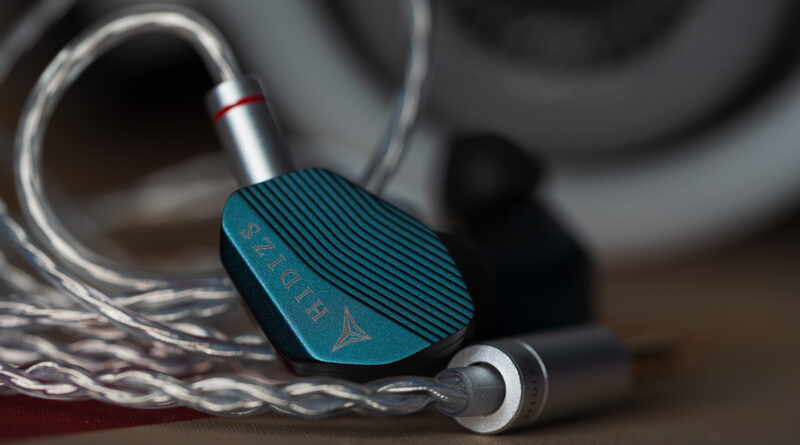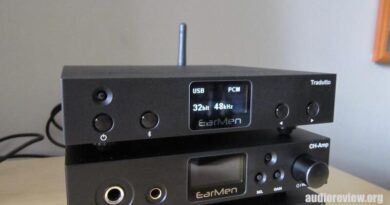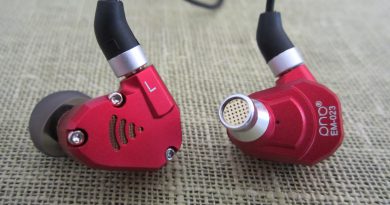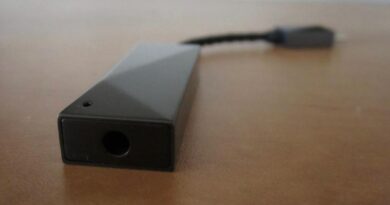Hidizs MP143 Salt Review – Cheaper, Lighter… Better?
Pros — Excellent build and comfort
– Tuning nozzles have palpable differences in presentation
– Very good bass slam and speed
– Does not sound as “narrow” as most planar magnetic IEMs
Cons — Lower mids can sound a bit hazy on the MP143
– Subdued upper-treble
– Not the most resolving planar in the budget realm
In this Article
INTRODUCTION
Hidizs’s debut planar magnetic IEMs, the MP145, have garnered somewhat of a cult following. Many, including yours truly, consider them to be the best “budget” planar magnetic IEMs in the market. Even over a year after their release, that crown is yet to slip, so I guess Hidizs pretty much nailed down the formula for a breakout hit with that one.
To recapture that mythical “lightning in a bottle” twice, Hidizs has now come up with the MP143, nicknamed “Salt” (referring to the female Humpback Whale with an interesting backstory). Hidizs has kept its collaboration with WDC (Whale and Dolphin Conservation) alive and thriving, something that deserve applause.
The primary selling points over the predecessor are the lighter weight, and a price-tag that’s easier on the wallet. The shape of the earpieces have also been modified for a more ergonomic fit. We are here for the sound improvements though, if there are any. Time to dig deeper.
Note: the ratings given will be subjective to the price tier. Meze Audio was kind enough to send me the Alba for evaluation.
Sources used: Questyle CMA Twelve Master
Price, while reviewed: $120 Can be bought from Hidizs.
PHYSICAL THINGS AND USABILITY
PACKAGING AND ACCESSORIES
One of my issues with the MP145 was the use of plastic in packaging. For a product that advocates saving marine life, the use of plastic was somewhat of a cruel irony.
Thankfully, the MP143 comes with an environmentally sustainable and recyclable packaging. Kudos to Hidizs for that. The accessories are good enough to get you going, with 6 pairs of silicone eartips, a carrying pouch, three tuning filters (more on these in the sound section), and a 4-core SPC cable with the choice of 3.5mm or 4.4mm termination.
BUILD QUALITY
The fin-like back-plate design makes a reappearance on the MP143, even though the overall profile is more slender now. The nozzle angle is also tilted upward, helping to achieve a more secure fit.
The venting mechanism has been modified, with one vent near the nozzle and another beside the 2-pin connectors. This placement helps with reducing the driver-flex issue that the predecessor sometimes suffered due to one of the vents being on the back.
Hidizs has continued using the same screwed-on nozzle filter design on the MP143, with additional nozzles providing more or less bass and/or treble depending on the nozzle filter that’s placed inside (different mesh filters can dampen specific frequencies). You can further experiment with foam inserts, so there is room for some DIY tweaking.
All in all, excellent build quality and an overall unique design (I love the blue colorway by the by).
COMFORT, ISOLATION, AND FIT
Each earpiece of the MP143 weighs around 8g (with tips), placing them around the middle of the weight spectrum. Nonetheless, due to the aforementioned ergonomic nozzle and shell design, most should be able to get a snug, comfortable fit and good isolation. If you need the maximum isolation, foam tips might be a better option than the supplied silicone ones.
SOURCE AND EARTIPS
At 103 dB/mW sensitivity and 17 ohm impedance, the MP143 are easy to drive. Most modern dongles should power them from the 3.5mm jack alone, but to get more headroom in terms of distortion and dynamics, going balanced might be the better option.
For the majority of the review, I used the desktop Questyle CMA Twelve Master as the source while using the stock tips and cable. Somewhat of an overkill of a source, but it helps alleviate any concern regarding “under-driving” the IEMs.
DRIVER SETUP
Hidizs MP143 utilize a single, 14.3mm planar magnetic driver with seven magnets on either side of the driver. These magnets are arranged in the typical “window-shade” like structure and generally allows for a more even distribution of magnetic flux across the etched voice coil.
HIDIZS MP143 TONALITY AND TECHNICALITIES
The general tuning of the MP143 is dependent on the nozzle being used. To my ears, the rose-gold tips offer the most “balanced” sound of the lot.
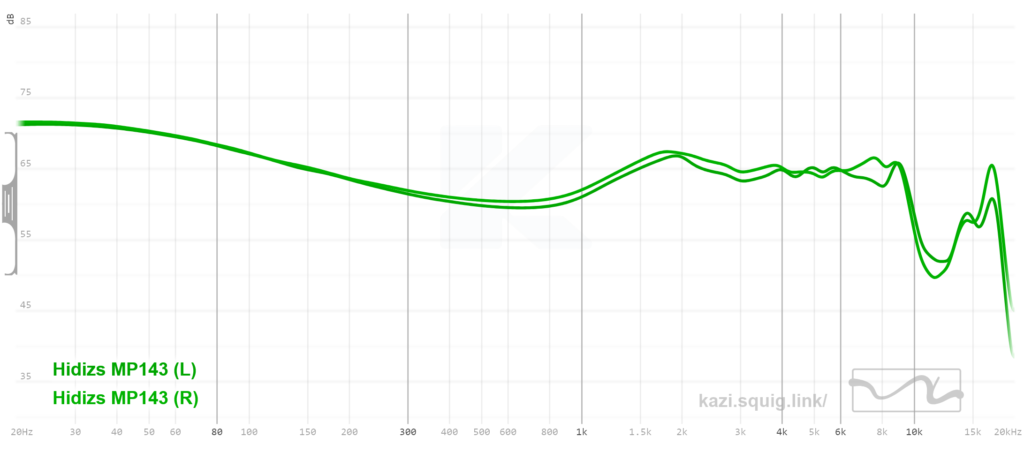
With the stock (rose-gold) filter, the tuning is leaning toward the warmer side of things, with a reserved upper-mid elevation (around 7dB above the lower-midrange). While Hidizs claims that the tuning is “perfectly aligned” with the Harman 2019 V2 curve, in reality there are some noticeable deviations, especially with the gold and red filters.
Male vocals can sound overly thick at times due to the somewhat early rise in the upper-bass region (around 300Hz). This can make it difficult to pick out subtleties such as slight changes in pitch or articulation. Coupled with the reserved upper-midrange on the rose-gold filter, soaring vocals lack their usual energy and focus.
The silver filter has around 2dB of boost near the upper-midrange, resulting in better clarity for the vocals. However, due to lower-mids remaining virtually unchanged, the sub-bass haze can encroach into the lower-mids and mask low-level details. The red filter is the worst offender here, with an even more aggressive bass shelf and completely subdued upper-midrange. Proper “resolution killer”, if that’s the term. Avoid this one if you love your vocals.
If you do not care about vocals and only want thick bass, then the red filter might fit your preferences. Even then, the bass is boomy and fast bass notes smear into each other. The gold filter provides a better balance between sub and upper-bass frequencies, so that’s what I ended up preferring when I needed a more “fun” presentation.
None of the filters are particularly adept at handling upper-treble frequencies, with the region between 9 – 15 kHz sounding dead and hollow. This kills the airiness of cymbals and hi-hats, and the general sense of “openness” is compromised. If you prefer some shimmer and air up top, the MP143 will disappoint.
As for the spatial qualities, staging has above-average width and depth for a planar magnetic IEM, while imaging is strong in terms of left and right separation. Ordinal orientations are not a strong suit, however. Macrodynamic punch is not as dramatic and “tight” as I prefer, while microdynamics are not that evident.
Overall, the MP143 lean overly warm at times which, while helping to avoid listener fatigue, can also sound a bit bland and boring. The silver filter is the one I’d go with if you want the best balance and the “cleanest” sound, while the gold filter will sound more laid-back and atmospheric. The red filter is just a red flag so… avoid.
SELECT COMPARISONS
I was most interested in comparing the MP143 against their big brother: the MP145.
Overall build is similar between both, but the MP143 are lighter and just look more streamlined. The MP145 feel more solid in hand but have a more industrial feel to them. The MP145 also come with a beefier stock cable.
As for the sound, the MP145 have a more balanced upper-mid tuning, while the sub-bass is slightly less egregious, resulting in somewhat cleaner rendition of male vocals.
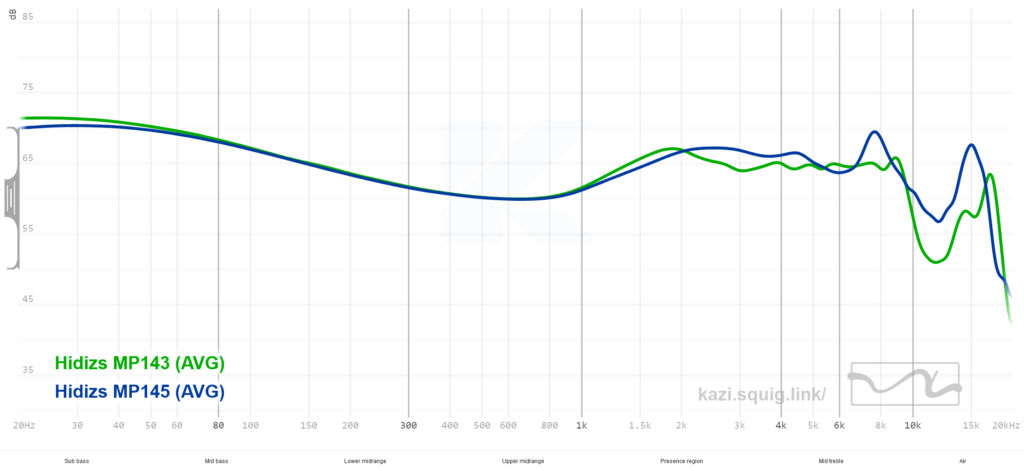
The most tantalizing difference comes in the form of the upper-treble response, where the MP145 pull noticeably ahead. In Dave Matthews Band’s #41, the cymbals and hi-hats are far more pronounced in both attack and decay on the more expensive model.
This extra airiness helps in imparting a sense of openness as well, with both the stage width and height being more expansive on the MP145.
Comfort is the one advantage that MP143 have, thanks to them being 2g lighter and having less bulk in the housing.
In short, if you want more treble extension and better staging, spend the extra money and get the MP145. If you are easily fatigued by treble peaks in the air frequencies or just need more bass, the MP143 should be a better fit.
CONCLUDING REMARKS
The MP143 sport a tuning choice that is not too prevalent in the planar realm. Most manufacturers try to go for a brighter, more “bombastic” tuning with the planars due to these drivers having excellent distortion properties.
Hidizs goes the other way and focuses on long-term listening comfort rather than force extra sense of “resolution” or overly-energized bass and treble.
The biggest problem of the MP143 is that the MP145 exist. The latter are superior in every aspect other than weight and (for some) comfort. I also think that the stock price is a bit higher on the MP143 as for just extra $30, you get better tuning and technicalities.
If you find the MP143 for a good discount (approx. USD$30 off the MSRP), then they become a more enticing prospect. At sticker price, I think they perform below expectations.
MY VERDICT
3.5/5
DISCLAIMER
Our generic standard disclaimer.



